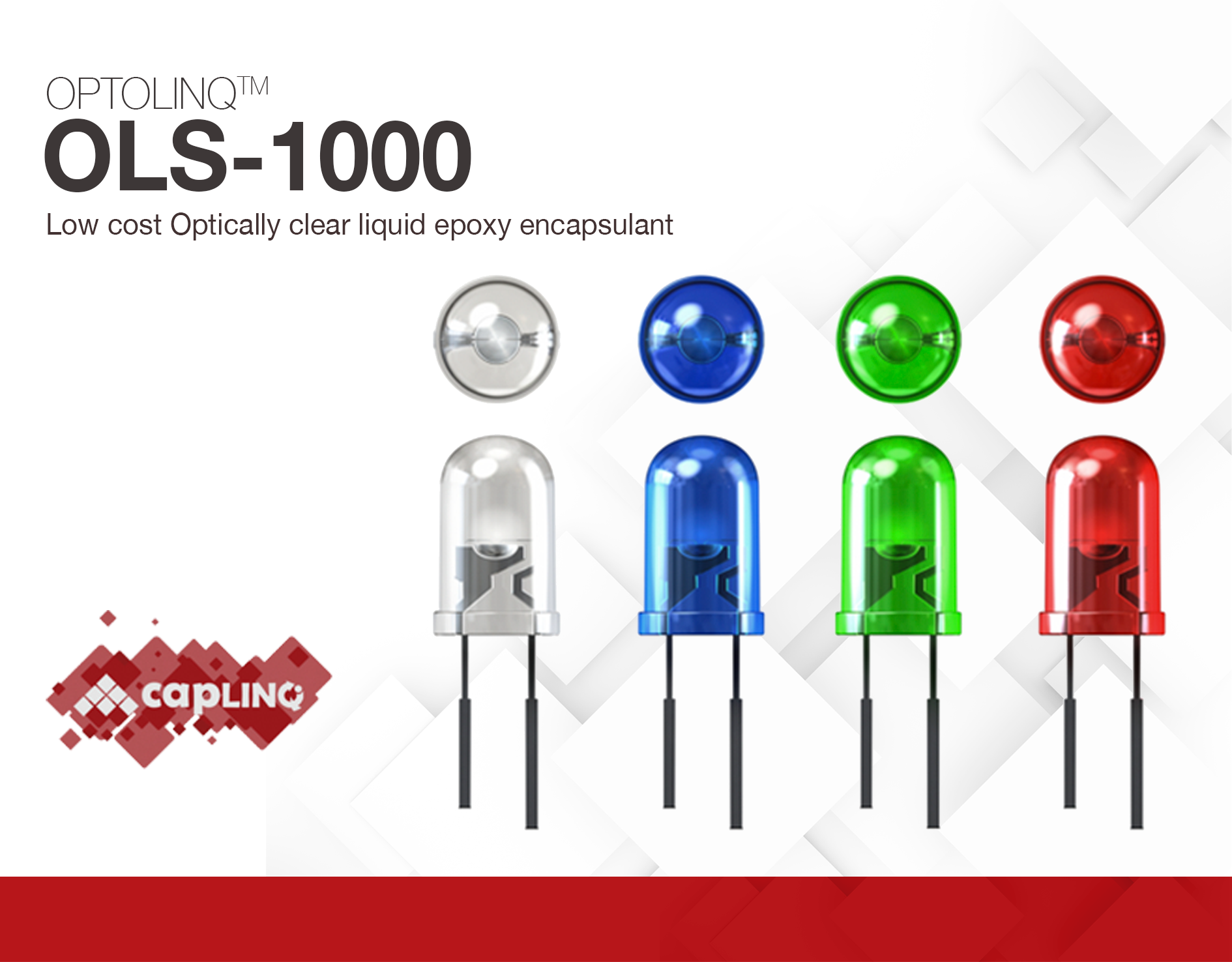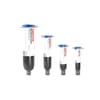OLS-1000 | Liquid Encapsulant - Two part Epoxy
- Liquid epoxy encapsulant
- Cost/Performance balance
- Value engineered - Low cost
Product Description
OPTOLINQ OLS-1000 is a two-part (Part A & Part B), optically clear epoxy casting compound designed for the encapsulation of LED lamps and displays. It features excellent UV resistance, high optical transmittance, high adhesion to a range of substrates, and good thermal shock resistance. It is geared specifically for applications that will not be exposed to temperatures above 125°C, and where the cost of the encapsulation material is a large percentage of the final part cost. The OLS-1000 has been value-engineered to provide the minimum level of acceptable performance for the absolute lowest cost.
OPTOLINQ OLS-1000 has been used extensively for low-power LED encapsulation, automatic LED casting, and potting of large optoelectronic modules. Each of these applications relies on the high clarity and other optical properties of the OLS-1000 as well as its excellent mechanical properties. The OLS-1000 can be colored and diffused by the addition of specific dye concentrates and diffusant concentrates. This product is not made for SMD encapsulation but mainly for DIP packages.
Technical Specifications
| General Properties | |||||||
| Chemistry Type | Epoxy | ||||||
| Refractive index Refractive index The refractive index determines how much the path of light is bent, or refracted, when entering a material. It is calculated by taking into account the velocity of light in vacuum compared to the velocity of light in the material. The refractive index calculation can be affected by the wavelength of light and the temperature of the material. Even though it is usually reported on standard wavelengths it is advised to check the TDS for the precise test parameters. | 1.52 | ||||||
| Specific Gravity Specific Gravity Specific gravity (SG) is the ratio of the density of a substance to the density of a reference substance; equivalently, it is the ratio of the mass of a substance to the mass of a reference substance for the same given volume. For liquids, the reference substance is almost always water (1), while for gases, it is air (1.18) at room temperature. Specific gravity is unitless. | 1.16 | ||||||
| Chemical Properties | |||||||
| Moisture absorption | 0.35 % | ||||||
| Mechanical Properties | |||||||
| |||||||
| Electrical Properties | |||||||
| Volume Resistivity Volume Resistivity Volume resistivity, also called volume resistance, bulk resistance or bulk resistivity is a thickness dependent measurement of the resistivity of a material perpendicular to the plane of the surface. | 1.0x1014 Ohms⋅cm | ||||||
| Thermal Properties | |||||||
| |||||||
| Glass Transition Temperature (Tg) Glass Transition Temperature (Tg) The glass transition temperature for organic adhesives is a temperature region where the polymers change from glassy and brittle to soft and rubbery. Increasing the temperature further continues the softening process as the viscosity drops too. Temperatures between the glass transition temperature and below the decomposition point of the adhesive are the best region for bonding. The glass-transition temperature Tg of a material characterizes the range of temperatures over which this glass transition occurs. | 130 °C | ||||||
| Temperature Resistance Temperature Resistance Temperature resistance is the maximum temperature that the material or product can withstand for a period of time. The temperatures listed should be considered as guidelines for an operating temperature of about 30 minutes. Typically, the material can withstand much longer times at temperatures about 20°C lower and can withstand much higher temperatures for short, intermittent times. | 125 ˚C | ||||||
Additional Information
Additional Handling Instructions
Preheat Part A to 40°C and then mix in Part B in the required mixing ratio given above. Ideally, the mixture of Part A and B will be done in a vacuum and degassed at 3 torr (400 Pa) for 10-15 minutes. This will ensure that all the entrapped air bubbles are removed after mixing. For best results, ensure that all moisture has been removed from the parts to be encapsulated by preheating them for 1 hour @ 90°C. Also for best results, the encapsulation should be carried out in a vacuum.
Using Additives with OLS-1000
Optolinq OLS-1000 can be mixed with diffusing agents or color pastes to achieve customer-specific purposes.
Recommended quantity (in weight %) of various diffusing agents and color pastes to be used with OLS-1000:
- OCP01-R Red Color Paste: 2-5% by weight
- OCP01-B Blue Color Paste: 1-3% by weight
- OCP01-G Green Color Paste: 2-4% by weight
- ODF-10 Diffusing Agent: 2-5% by weight
Values with our latest pastes and agents TBD.
Storage and Handling
OPTOLINQ OLS-1000 is supplied in cans and jars and should be kept in a cool (10°C – 25°C) dry place (40% – 75% humidity) away from direct sunlight or temperature extremes. Part B is particularly sensitive to moisture, so be sure to remove moisture after using and to keep the lid of the container tightly sealed after use.
For safe handling information on this product, consult the Safety Data Sheet, (SDS).
The data contained herein may be reported as a typical value and/or range values based on actual test data and are verified on a periodic basis.









